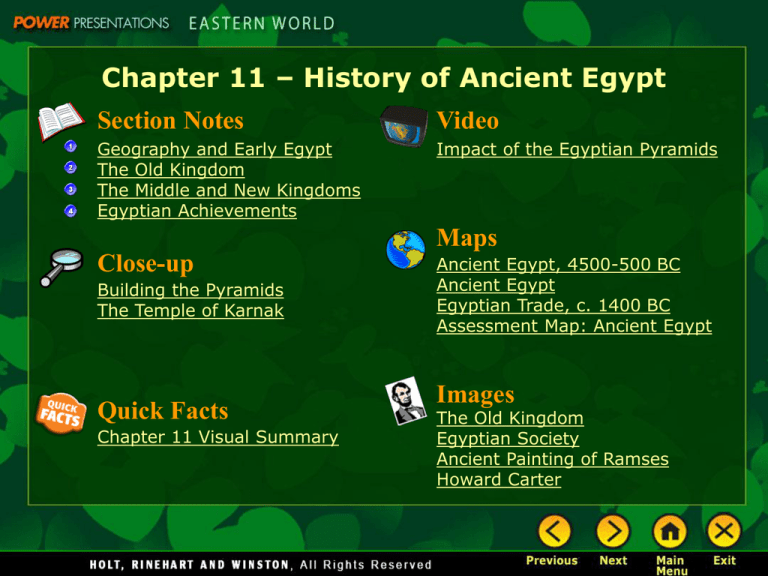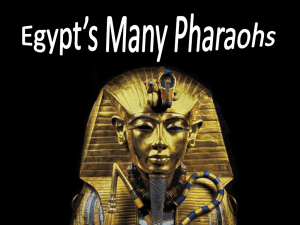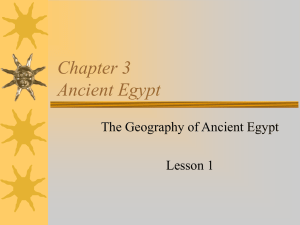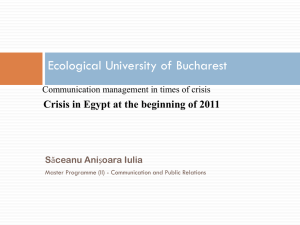SSWGEegy - Mr Boayue`s Social Studies site
advertisement

Chapter 11 – History of Ancient Egypt Section Notes Video Geography and Early Egypt The Old Kingdom The Middle and New Kingdoms Egyptian Achievements Impact of the Egyptian Pyramids Close-up Building the Pyramids The Temple of Karnak Quick Facts Chapter 11 Visual Summary Maps Ancient Egypt, 4500-500 BC Ancient Egypt Egyptian Trade, c. 1400 BC Assessment Map: Ancient Egypt Images The Old Kingdom Egyptian Society Ancient Painting of Ramses Howard Carter Geography and Early Egypt The Big Idea The water and fertile soils of the Nile Valley enabled a great civilization to develop in Egypt. Main Ideas • Egypt was called the gift of the Nile because the Nile River was so important. • Civilization developed after people began farming along the Nile River. • Strong kings unified all of ancient Egypt. Main Idea 1: Egypt was called the gift of the Nile because the Nile River was so important. • The Nile River, the longest river in the world, brought life to Egypt and enabled it to thrive. – It begins in central Africa and runs north through Egypt to the Mediterranean Sea. – The civilization of ancient Egypt developed along a 750-mile stretch of the Nile. • Ancient Egypt included two regions, southern and northern. – Southern Egypt was called Upper Egypt because it was upriver in relation to the Nile’s flow. – Northern Egypt, or Lower Egypt, was downriver. The Nile • South of Egypt, rocky terrain caused cataracts, or rapids, to form. – The first cataract marked the southern border of Upper Egypt. – Five more cataracts lay farther south. • In Lower Egypt, the Nile divided into several branches that fanned out and flowed into the Mediterranean Sea. – These branches formed a delta, a triangle-shaped area of land made from soil deposited by a river. – Two-thirds of Egypt’s fertile farmland was located in the Nile Delta. • Each year rainfall south of Egypt caused floods in Upper Egypt in mid-summer and in Lower Egypt in the fall. – The Nile’s flooding coated the land around it with a rich silt. – Without the Nile’s regular flooding, people never could have farmed in Egypt. Main Idea 2: Civilization developed after people began farming along the Nile River. Hunter-gatherers first moved into the Nile Valley more than 12,000 years ago. By 4500 BC farmers living in small villages grew wheat and barley. Over time farmers in Egypt developed an irrigation system. Egyptians enjoyed a varied diet, with wheat, barley, fruits, vegetables, cattle, sheep, fish, wild geese and ducks. Two Kingdoms • Egypt’s location had natural barriers, which made it hard to invade Egypt. – To the west, the desert was too big and harsh to cross. – To the north, the Mediterranean Sea kept many enemies away. – To the east, more desert and the Red Sea were barriers. – To the south, Nile cataracts made sailing into Egypt hard. • Villages grew—wealthy farmers became village leaders— strong leaders controlled several villages— villages banded together to form two kingdoms. • Capital of Lower Egypt was Pe in the Nile Delta. • Capital of Upper Egypt was Nekhen on the Nile’s west bank. Main Idea 3: Strong kings unified all of ancient Egypt. • According to tradition, Menes rose to power in Upper Egypt around 3100 BC. – Invaded Lower Egypt and married one of their princesses to unify the two kingdoms – Many consider Menes to be Egypt’s first pharaoh, the title used by the rulers of ancient Egypt. – Founded Egypt’s first dynasty, or series of rulers from the same family. – Built a new capital city, Memphis, at the southern tip of the Nile Delta. • Egypt’s First Dynasty lasted for about 200 years. • In time some 30 dynasties would rule ancient Egypt over a span of more than 2,500 years. The Old Kingdom The Big Idea Egyptian government and religion were closely connected during the Old Kingdom. Main Ideas • Life in the Old Kingdom was influenced by pharaohs, roles in society, and trade. • Religion shaped Egyptian life. • The pyramids were built as tombs for Egypt’s pharaohs. Main Idea 1: Life in the Old Kingdom was influenced by pharaohs, roles in society, and trade. • The Old Kingdom lasted for about 500 years, from about 2700 to 2200 BC, beginning with the Third Dynasty. • Ancient Egyptians believed that Egypt belonged to the gods, and the pharaoh had come to Earth in order to manage Egypt for the rest of the gods. • The most famous pharaoh of the Old Kingdom was Khufu, who ruled in the 2500s BC. He is best known for the monuments that were built to him. Society and Trade As Egypt’s population grew, social classes appeared. Egyptians believed that a well-ordered society would keep their kingdom strong. Pharaoh Egypt’s ruler, also considered to be a god Nobles Officials and priests, many nobles, people from rich and powerful families Middle Class Lesser government officials, scribes, and rich craftspeople Lower Class Farmers, servants, and slaves As society developed, trade grew as Egypt traded with neighbors for gold, copper, ivory, slaves, stone, and wood. Main Idea 2: Religion shaped Egyptian life. • Worshipping the gods was a part of daily life. • The Egyptians practiced polytheism. • Before the First Dynasty each village worshipped its own gods. • During the Old Kingdom, Egyptian officials expected everyone to worship the same gods. • The Egyptians build temples to the gods all over the kingdom. • Egyptian families also worshipped household gods at shrines in their homes. Major Egyptian Gods Ptah Anubis Re Osiris Isis • Creator of the world • God of the dead • Sun god • God of the underworld • Goddess of magic Horus • Sky god; god of the pharaohs Thoth • God of wisdom Geb • Earth god Emphasis on the Afterlife • Much of Egyptian religion focused on the afterlife, or life after death. • The Egyptians believed that the afterlife was a happy place. • The Egyptian belief in the afterlife stemmed from their idea of ka, or a person’s life force. – When a person died, his or her ka left the body and became a spirit, but could not leave its burial site. – It had all the same needs as a living person. • Egyptians believed that a body had to be preserved so that its spirit could recognize it. – They developed a method called embalming to preserve bodies and to keep them from decaying. – They preserved bodies as mummies, specially treated bodies wrapped in cloth. • Only royalty and other members of Egypt’s elite, or people of wealth and power, could afford to have mummies made. Main Idea 3: The pyramids were built as tombs for Egypt’s pharaohs. The Egyptians believed that burial sites, especially royal tombs, were very important, so they built spectacular monuments in which to bury their rulers. The most spectacular were the pyramids—huge, stone tombs with four triangle-shaped sides that met in a point on top—first built during the Old Kingdom. The largest is the Great Pyramid of Khufu near Giza. It is an amazing example of Egyptian engineering, the application of scientific knowledge for practical purposes. Pyramids required huge labor forces. As many as 100,000 workers may have been paid to work on just one pyramid. Significance of the Pyramids Burial in a pyramid showed a pharaoh’s importance. Both the size and shape of the pyramid were symbolic. Pointing to the sky above, the pyramid symbolized the pharaoh’s journey to the afterlife. Egyptians believed the pharaoh, as their link to the gods, controlled everyone’s afterlife. To ensure the pharaoh’s safety after death, the Egyptians sometimes wrote magical spells and hymns on tombs. Together, these spells and hymns are called Pyramid Texts. The Middle and New Kingdoms The Big Idea During the Middle and New Kingdoms, order and greatness were restored in Egypt. Main Ideas • The Middle Kingdom was a period of stable government between periods of disorder. • The New Kingdom was the peak of Egyptian trade and military power, but its greatness did not last. • Work and daily life differed among Egypt’s social classes. Main Idea 1: The Middle Kingdom was a period of stable government between periods of disorder. • At the end of the Old Kingdom, the wealth and power of the pharaohs declined. – In time, nobles gained enough power to challenge the pharaohs. – By about 2200 BC the Old Kingdom had fallen and local nobles ruled for the next 160 years. • Around 2050 BC a powerful pharaoh defeated his rivals, reuniting Egypt and beginning the Middle Kingdom, a period of order and stability that lasted to about 1750 BC. • Around 1750 BC the Hyksos from Southwest Asia invaded and conquered Lower Egypt. – They ruled the region as pharaohs for 200 years. Main Idea 2: The New Kingdom was the peak of Egyptian trade and military power, but its greatness did not last. Building an Empire • In the mid-1500s BC Ahmose of Thebes drove the Hyksos out of Egypt. • Start of the New Kingdom, the period during which Egypt reached the height of its power and glory • Egypt’s leaders conquered a large area, including kingdom of Kush, south of Egypt. • By the 1400s BC Egypt’s empire extended from the Euphrates River to southern Nubia. Growth and Effects of Trade • As empire expanded, so did trade. • Conquest brought Egyptian traders into contact with more distant lands and profitable trade routes, or paths followed by traders, developed from Egypt to these lands. • One of Egypt’s rulers who worked to increase trade was Queen Hatshepsut who used the money gained from trade to support the arts and architecture. Invasions of Egypt Hittites • In the 1200s BC the pharaoh Ramses II, or Ramses the Great, fought the Hittites from Asia Minor. Neither could defeat the other. Tehenu The Sea Peoples • The Tehenu invaded the Nile Delta and were defeated by Ramses. • Soon after Ramses the Great died, the Sea Peoples invaded. • Built a series of forts to strengthen Egypt’s defenses, and the Tehenu were defeated again when they invaded a century later. • They crushed the Hittites and destroyed cities in Southwest Asia. • The Egyptians turned them back after 50 years of fighting. Main Idea 3: Work and daily life differed among Egypt’s social classes. A complex society requires people to take on different jobs. In Egypt, these jobs were often passed on within families. • Worked for the government and the temples Scribes • Kept records and accounts, wrote and copied religious and literary texts • Worked for the government and the temples Artisans Architects and Artists • Sculptors, builders, carpenters, jewelers, metalworkers, and leatherworkers • Designed the temples and royal tombs • Artists worked for the state and temples, and painted the walls of the pharaohs’ tombs Merchants, Soldiers, Peasants, and Slaves • Small group of Egyptians were traders Merchants • Usually accompanied by soldiers, scribes, and laborers • Professional army Soldiers • Received land as payment, kept captured treasure, promotion to officer possible • Vast majority of Egypt’s population Farmers and • Paid crops as taxes; worked on special Peasants projects for the pharaoh Slaves • Worked farms, projects, workshops, and homes • Had some legal rights • Could earn their freedom Family Life in Egypt • Most Egyptian families lived in their own homes. • Men were expected to marry young so that they could start having children. • Most Egyptian women were devoted to their homes and families. • Some women had jobs outside the home, serving as priestesses and working as royal officials, administrators, or artisans. • They could own property, make contracts (binding legal agreements), divorce their husbands, and keep their property after a divorce. • Children’s lives were less structured. They hunted and played with balls, dolls, tops, and animal figurines. • At school, they learned morals, writing, math, and sports. • At age 14 most boys entered their father’s profession. Egyptian Achievements The Big Idea The Egyptians made lasting achievements in writing, art, and architecture. Main Ideas • Egyptian writing used symbols called hieroglyphics. • Egypt’s great temples were lavishly decorated. • Egyptian art filled tombs. Main Idea 1: Egyptian writing used symbols called hieroglyphics. Hieroglyphics, the Egyptian writing system, were one of the world’s first writing systems. The earliest known examples are from around 3300 BC. Later, Egyptians learned how to make papyrus, a long-lasting, paperlike material made from reeds. Scribes wrote on papyrus using brushes and ink. The hieroglyphic writing system used more than 600 symbols. Hieroglyphics could be written in any direction. The Rosetta Stone and Egyptian Texts Rosetta Stone • People have known about hieroglyphics for centuries, but did not know how to read them. • In 1799 a French soldier found the Rosetta Stone, a huge, stone slab inscribed with hieroglyphics, Greek, and a later form of Egyptian. • Because the message in all three languages was the same, scholars who knew Greek were able to translate the hieroglyphics. Egyptian Texts • Because papyrus did not decay in Egypt’s dry climate, many ancient Egyptian texts still survive. • They include government records, historical records, science texts, medical manuals, and literary works, including The Book of the Dead, telling about the afterlife. Main Idea 2: Egypt’s great temples were lavishly decorated. • Temples were the homes of the gods. • People worshipped, offered gifts, and asked for favors. • Common temple features: – Rows of stone sphinxes—imaginary creatures with the bodies of lions and the heads of other animals or humans—lined the entrance path. – Entrance was a huge, thick gate. – On either side might stand an obelisk, a tall, four-sided pillar that is pointed on top. – Inside was lavishly decorated, with huge columns supporting the roof, often covered with paintings and hieroglyphics like the walls. Main Idea 3: Egyptian art filled tombs. Many of the Egyptians’ greatest works were created to fill the tombs of pharaohs and nobles because they believed the dead could enjoy them in the afterlife. • Egyptian artists painted on tomb and temple walls, canvas, papyrus, pottery, plaster, and wood. Paintings • Subjects included historical events, major religious rituals, and scenes from everyday life. • More important figures are larger than less important people. Stonework Jewelry • Huge statues and detailed carvings • Made for men and women out of gold and precious stones Click on the window to start video









